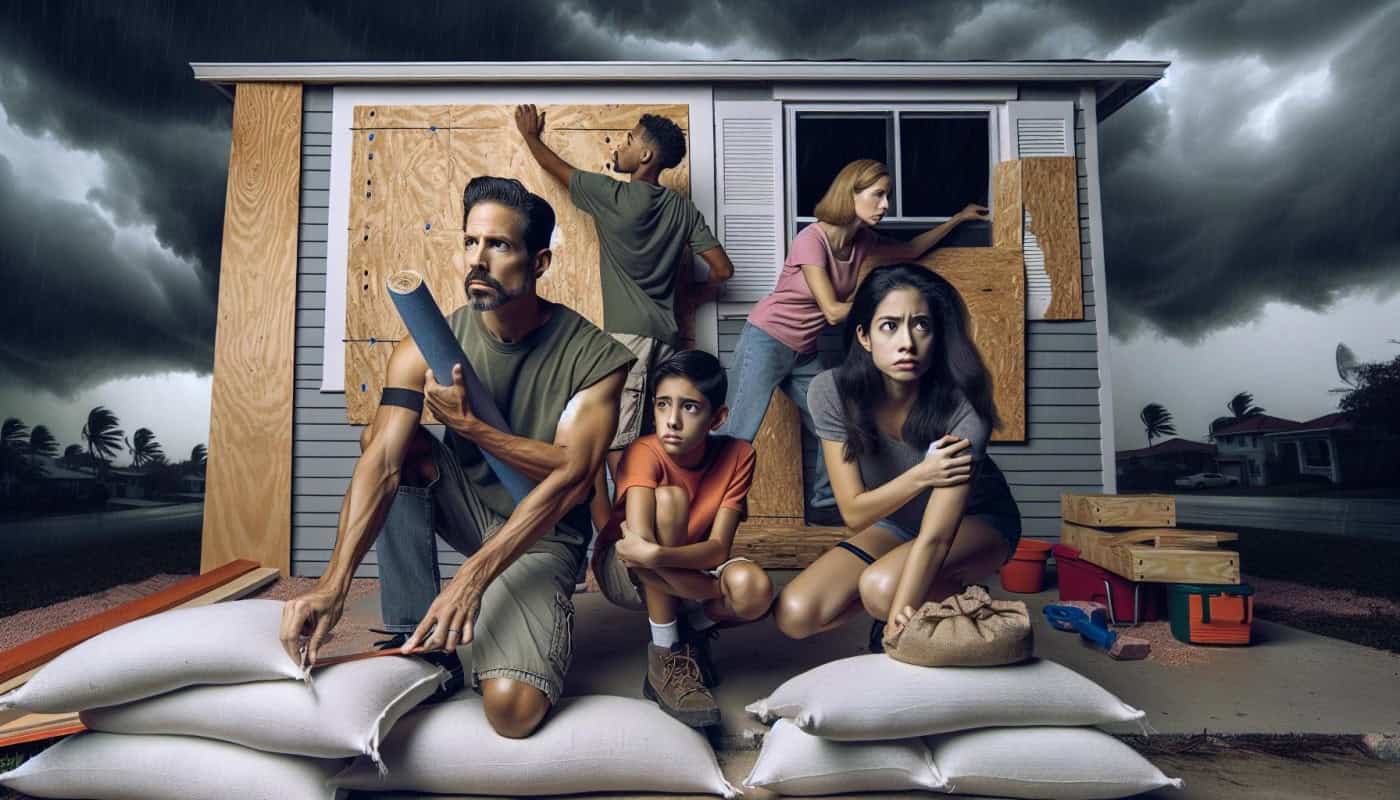As an avid weather watcher, there’s nothing quite like the adrenaline rush when a tropical storm watch escalates to a hurricane warning. Suddenly, the stakes are higher, the winds are stronger, and the rain is heavier. This is exactly what’s happening right now in Miami-Dade, a place known for its sunny skies and vibrant beaches.
The Initial Tropical Storm Watch
This part delves into the starting point – the tropical storm watch, and reminds us of Florida’s prior encounters with such incidents.
What is a Tropical Storm Watch?
A tropical storm watch, as its name implies, is an alert. It’s a notification issued by meteorological agencies when conditions are conducive for a tropical storm to develop within a defined area in the next 48 hours. So, in a nutshell, it’s a heads-up allowing affected areas to make adequate preparations. For instance, residents might ensure their homes are hurricane-proof or stock up on emergency supplies.
Florida’s Past Experience with Tropical Storms
Florida’s got a long history with tropical storms. In the past decade, the Sunshine State has witnessed 19 tropical storms, each escalating to varying degrees. One significant example of Florida’s tryst with such weather patterns is Hurricane Irma of 2017. Ranked as the fifth costliest hurricane in U.S history, Irma caused unprecedented damage across the state, disrupted power supply, and led to significant evacuation efforts. Remembering drastic instances like these often drives home the need to heed early warnings and take timely action.
Upgraded to Hurricane Warning for Miami-Dade
Riding on the back of the previous discussion, we shift gears, focusing on the upgrade from a tropical storm watch to a hurricane warning in Miami-Dade. Here’s how it matters and the factors that trigger this change.
Criteria for Upgrading a Storm Watch to a Hurricane Warning
Transitioning from a storm watch to a hurricane warning isn’t random. It’s a measured move, based on specific criteria.
- Increase in Wind Speed: For an upgrade to occur, there’s generally an escalation in wind speed sustained for a brief period. Usually, speeds need to exceed 73 mph.
- Weather Patterns: Weather satellites and radar tracking help predict the behavior of the storm. If the storm’s trajectory shows it’s becoming more organized and increasing in intensity, an upgrade becomes necessary.
Specificity reigns supreme when declaring a storm watch a hurricane warning; it’s about safety, after all.
How Miami-Dade is Affected
Being upgraded to a hurricane warning brings a whirlwind of changes to Miami-Dade.
- Evacuation: In many instances, a hurricane warning triggers evacuations, especially in Miami-Dade’s low-lying areas. Residents may need to leave their homes to stay safe.
- Emergency Response: The local government gears up for action. It’s an intensified effort ramping up from storm watch conditions; public services may be put on hold, and first responders brace themselves for action.
In essence, an upgrade to a hurricane warning dramatically impacts Miami-Dade’s normal operations, affecting both residents and public services. Understanding the meaning and implications of this upgrade is paramount for residents’ safety and wellbeing.
The Potential Impact of a Hurricane
The potential impact of a hurricane cannot be underestimated. We’ll delve into how a hurricane can cause havoc in an urban area before moving onto its economical implications.
How Hurricanes Damage Urban Areas
A hurricane’s destructive power, no doubt, results in extensive damage to urban areas. The strong winds, typically exceeding 74 miles per hour, can uproot trees, knock down power lines, and blow away roofs. Hurricane-induced tornadoes add to the mix, causing structural damage.
Inundation, another major concern, happens when hurricanes unleash their torrential rainfall. Miami-Dade, being coastal, faces the double whammy of excessive rainfall and storm surges, leading to widespread flooding. The floods, in turn, lead to property damage, ruin roads, and disrupt transportation services, isolating neighborhoods.
The power outages induced by hurricanes affect millions of people. Crucial services such as water treatment and emergency health care can get halted, exacerbating the situation further.
The Economic Consequences of Hurricanes
Hurricanes also bring along an economic havoc. The property damage, as described before, incurs immeasurable costs. Buildings, homes, and infrastructure often need repairs or reconstruction, all of which can be both timely and expensive.
Moreover, the disruption to transportation and businesses result in significant economic loss. Shops may remain closed for a significant duration, while goods and services cannot reach their due destinations. The economic impact, thus, isn’t restricted to the areas directly hit but also ripple through the national economy.
Then, there’s loss of jobs, at least temporarily, especially in sectors like tourism, which Miami-Dade heavily relies on. Added to this is the cost of evacuations, emergency response efforts, and post-hurricane recovery and rebuilding efforts.
In essence, hurricanes, while bringing in the awe of natural forces, also underline the cost and consequences it bears upon urban and economic fabrics.
Preparations and Response in Miami-Dade
Navigating the turbulent times following a hurricane warning necessitates robust preparations and response strategies. Miami-Dade has proven measures in place to combat the imminent threat.
Evacuation Plans and Shelters
Miami-Dade’s foresight shines through their well-articulated evacuation plans. Evacuation zones, largely determined by properties’ proximity to the coast, are classified alphabetically from A to E. Zone identification involves considering the residence’s elevation, distance from the shore, and likelihood of storm surges. For example, Zone A represents the areas most vulnerable to flooding and hence the first to evacuate.
Shelters, the residents’ haven in times of displacement, abound in Miami-Dade. The county has over 80 designated shelters with a combined capacity of approximately 100,000 people. These include general population shelters, pet-friendly shelters, and facilities tailored for individuals with special needs. Like, North Miami Beach Senior High School, a general population shelter, or E. Darwin Fuchs Pavilion, a pet-friendly shelter.
The Role of Disaster Management Teams
Disaster management teams stand at the forefront of Miami-Dade’s preparations and response. They operate in tandem with state and federal agencies to coordinate disaster relief efforts. From issuing timely alerts, conducting mock drills, initiating evacuation orders, to setting up emergency shelters, their role is pivotal.
Miami-Dade’s disaster management teams also liaise with other critical services like hospitals, utilities and transport agencies to ensure continuity amid chaos. For instance, Miami-Dade Transit operates emergency bus services to transport evacuees to shelters, while Florida Power & Light work on minimizing disruptions to power supply and space for tree-related emergencies.
Lastly, training volunteers and community members in disaster preparedness forms an essential part of their tasks, making Miami-Dade a study in sustained readiness against hurricane threats.
Miami-Dade’s Future Outlook on Hurricanes
In the wake of transitioning from a tropical storm watch to a hurricane warning, it’s imperative to discuss Miami-Dade’s future outlook on hurricanes. This conversation will explore the potential influence of climate change on these natural disasters and delve into measures for building a more resilient county.
How Climate Change Might Impact Future Hurricanes
Scientific studies indicate that climate change might affect future hurricanes, altering their intensity, frequency, and paths. For instance, rising sea levels, a byproduct of global warming, could exacerbate storm surges, increasing the flood risk. Warmer ocean temperatures also provide more energy for storms, potentially leading to more intense hurricanes.
| Climate Change Impacts | Effect on Hurricanes |
|---|---|
| Rising Sea Levels | Increased storm surge and flooding |
| Warmer Ocean Temperatures | Increased intensity |
With climate change potentially amplifying the impact of hurricanes, it heightens the urgency for preparedness and resilience in Miami-Dade.
Measures to Build a Resilient Miami-Dade
Given the increasing threat of hurricanes, Miami-Dade aims to fortify its resilience through proactive measures. These include rigorous land-use planning restraints to limit development in flood-prone areas and rigorous building codes designed to withstand hurricane forces.
| Measure | Purpose |
|---|---|
| Land-use planning | Limit development in flood-prone areas |
| Rigorous building codes | Buildings designed to withstand hurricane forces |
Moreover, the county emphasizes community engagement in disaster preparedness and a comprehensive mitigation strategy involving infrastructure improvements, such as flood control projects. These concerted efforts reflect Miami-Dade’s commitment to its people’s safety and wellbeing amidst increasingly intense hurricanes.
Reflections on Past Hurricanes
Delving into histories of past hurricanes, we appreciate the gravity of Miami-Dade’s preparedness efforts. Their lessons gleaned from past tempests offer valuable insights, illuminating paths toward resilient futures.
Lessons Learned from Past Hurricane Episodes
My recollections journey back to some of the most formidable hurricane episodes Miami-Dade has encountered. These include Andrew in ’92, causing over $25 billion in damages, and later, on a national scale, Katrina in 2005, which proved to be one of the costliest hurricanes in US history.
Miami-Dade’s encounter with Andrew taught the importance of prompt evacuations. The efficiency of evacuations, executed by designated zones, set a groundbreaking precedent. It allowed for a swift and orderly retreat from the storm’s path, minimizing casualties.
From Katrina’s devastation, we learned the perils of insufficient levee systems. Miami-Dade now invests more robustly in flood control projects to better withstand flooding threats.
Increased reliance on precise forecasting technology is another significant lesson. It marvelously assists in early predictions about the storm’s path and intensity, allowing ample time for preparations.
Every hurricane episode has a profound story – a crude reminder of nature’s destructive potential, but also a testament to human resilience in the face of adversity. Through these lessons, Miami-Dade continues evolving its disaster response strategies, ensuring every hurricane does not become a cataclysm, but rather, an ordeal from which we emerge stronger.
Conclusion
So there you have it folks. Miami-Dade is once again on high alert as a tropical storm watch turns into a hurricane warning. It’s a stark reminder of the power of Mother Nature and the potential devastation she can bring. But it’s also a testament to the resilience and preparedness of our community. We’ve weathered storms before, like Andrew and Katrina, and we’ve learned valuable lessons from each. We’ve honed our evacuation strategies, improved our flood control measures, and invested in forecasting technology. We’re ready to face this new challenge head-on. After all, it’s not about avoiding the storm, but learning to dance in the rain. Stay safe out there, Miami-Dade. We’ll get through this, just like we always do.
- Husband of Actress Devon Aoki Arrested in Coral Gables Hit-and-Run - December 17, 2025
- “Operation El Primo” Dismantles Major Cocaine Ring in Miami - December 17, 2025
- Mother Seeks Justice After Son Killed During Alleged Home Invasion in Miami-Dade - December 16, 2025




